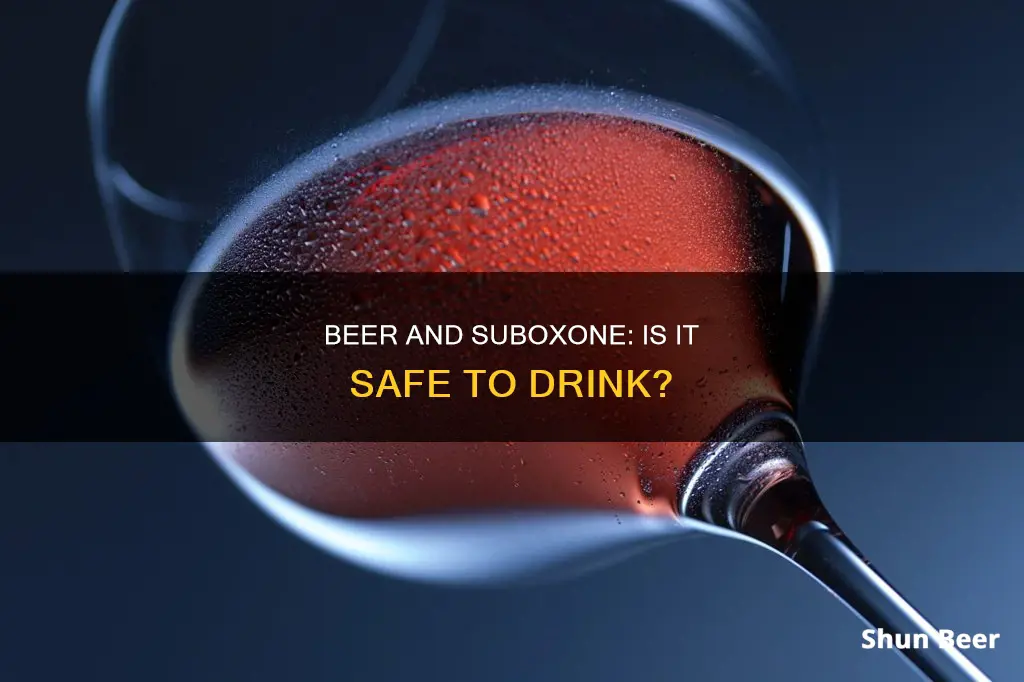
Suboxone is a narcotic painkiller used to treat opioid addiction and dependence. It is a combination opioid drug containing both buprenorphine and naloxone. While Suboxone is an effective treatment for opioid use disorder, it is not without its risks. Mixing Suboxone with alcohol is dangerous and can lead to a host of adverse effects. Both substances are central nervous system depressants, which means they slow breathing and heart rates. When combined, the effects of both substances are intensified, leading to increased side effects such as nausea, vomiting, dizziness, and fainting. The combination can also lead to more severe consequences such as respiratory depression, sedation, coma, and even overdose. Due to these risks, it is advised that individuals taking Suboxone avoid alcohol consumption altogether.
| Characteristics | Values |
|---|---|
| Should you drink beer while on Suboxone? | No, it is not advisable to mix Suboxone and alcohol. |
| Why? | Both substances are central nervous system depressants, which means they slow breathing and heart rates. |
| What happens when you mix them? | The effects of Suboxone and alcohol are intensified, and the risk of side effects and life-threatening consequences such as respiratory depression, sedation, and coma is increased. |
| What are the side effects? | Headache, dizziness, fainting, nausea, vomiting, heart palpitations, changes in blood pressure, increased risk of a heart attack, decreased motor coordination, poor response times, impaired thinking processes, lethargy, and more. |
| What are the long-term risks? | Increased risk of various cancers, cirrhosis of the liver, ulcers, brain damage, cardiovascular disease, weakened immune system, substance use disorder, and more. |
What You'll Learn
- CNS Depressants: Alcohol and Suboxone are both central nervous system depressants, which can lead to slowed breathing and heart rates
- Side Effects: Mixing alcohol with Suboxone can increase the intensity of side effects such as nausea, vomiting, and dizziness
- Overdose Risk: The combination of alcohol and Suboxone increases the risk of overdose and other life-threatening consequences
- Addiction and Dependence: Alcohol use disorders can increase the risk of fatal opioid overdose and contribute to polysubstance abuse
- Treatment Considerations: It is recommended to avoid alcohol during Suboxone treatment to prevent serious interactions and maintain recovery progress

CNS Depressants: Alcohol and Suboxone are both central nervous system depressants, which can lead to slowed breathing and heart rates
Alcohol and Suboxone are both central nervous system depressants. This means that they slow down breathing and heart rates, and can lead to a range of distressing and life-threatening side effects. The combination of the two can be extremely dangerous and even lethal.
Both substances suppress nerve activity in the central nervous system, and when combined, their effects are intensified. This can lead to severe drowsiness, impaired judgment, respiratory suppression, loss of consciousness, and an increased risk of overdose. The side effects of Suboxone, such as nausea, vomiting, headache, dizziness, and fainting, are also amplified when mixed with alcohol.
The intensified effects of the two substances can cause serious respiratory issues, including respiratory infections and tissue and organ damage due to hypoxia (decreased blood flow to organs and tissues). This can have severe consequences, including serious brain damage.
The combination of alcohol and Suboxone can also lead to decreased blood flow as a result of altered heart rates. This can cause further tissue and organ damage over time due to a lack of nutrients and oxygen reaching the organs and tissues.
The altered mental state caused by the combination of these substances can lead to an increased risk of accidents, risky behaviours, and intentional self-harm. It can also result in a comatose state due to the suppression of neurons in the brain stem that control automatic functions like breathing and heart rate. This can be potentially fatal or lead to severe brain damage and damage to other organs.
In summary, mixing alcohol and Suboxone can have severe and dangerous consequences due to their combined effects as central nervous system depressants. It is essential to avoid mixing these two substances to prevent the risk of serious side effects and health complications.
Ginger Beer and Pregnancy: Is It Safe?
You may want to see also

Side Effects: Mixing alcohol with Suboxone can increase the intensity of side effects such as nausea, vomiting, and dizziness
Mixing alcohol with Suboxone can have serious consequences. Both substances are central nervous system depressants, which means they slow breathing and heart rates. This can lead to a slowed heart rate, sedation, and even coma. The combination of these two substances can also increase the intensity of side effects such as nausea, vomiting, and dizziness.
Nausea and vomiting are unpleasant side effects of Suboxone use, and when alcohol is added to the mix, these symptoms can become more severe and difficult to manage. Dizziness is another common side effect of Suboxone, and when combined with alcohol, the risk of falls and injuries increases.
In addition to intensifying these side effects, mixing alcohol with Suboxone can also lead to other dangerous consequences. The combination can result in decreased respiratory drive, decreased awareness of surroundings, and slowed or stopped breathing. It can also impair judgment and increase the risk of engaging in risky behaviours. The risk of overdose is also significantly increased when these two substances are combined.
The bottom line is that mixing alcohol with Suboxone is dangerous and can have life-threatening consequences. It is important for individuals taking Suboxone to avoid alcohol consumption and seek alternative ways to manage any cravings or withdrawal symptoms they may experience.
Beer and Teenagers: What's the Deal?
You may want to see also

Overdose Risk: The combination of alcohol and Suboxone increases the risk of overdose and other life-threatening consequences
Combining alcohol and Suboxone can have life-threatening consequences. Both substances are central nervous system depressants, which means they slow down breathing and heart rates. When taken together, the effects of each substance are intensified, leading to a higher risk of overdose.
The combination of alcohol and Suboxone can cause severe respiratory depression, sedation, and even coma. It can also lead to a slowed heart rate, decreased blood flow, and increased risk of respiratory infections. The cognitive effects of both substances are also amplified, leading to impaired judgment, decision-making, and coordination. This can result in accidental injuries or engaging in risky behaviours.
The body's tolerance and dependence on Suboxone and alcohol also increase when they are combined. The body will require higher doses of Suboxone to achieve the same effects, leading to a vicious cycle of addiction and substance abuse.
Additionally, mixing alcohol with Suboxone can cause unpleasant symptoms such as nausea, vomiting, dizziness, fainting, and heart palpitations. It can also increase the risk of developing cardiovascular disease, cancer, and mental health issues such as depression and anxiety.
The risks of overdose and other life-threatening consequences are significantly heightened when alcohol is mixed with Suboxone. It is crucial to avoid combining these substances under any circumstances.
Drinking Beer: Bottle or Glass?
You may want to see also

Addiction and Dependence: Alcohol use disorders can increase the risk of fatal opioid overdose and contribute to polysubstance abuse
Alcohol use disorders can increase the risk of fatal opioid overdose and contribute to polysubstance abuse. Mixing alcohol with opioids can be extremely dangerous and even lethal. Alcohol and opioids are central nervous system depressants, meaning they affect the body in similar ways. When combined, the effects of each substance are amplified, and the risk of overdose increases. Alcohol can enhance the side effects of opioids, including headache, dizziness, fainting, nausea, and vomiting. The combination can also lead to heart palpitations, changes in blood pressure, and an increased risk of heart attack.
The cognitive effects of alcohol and opioids can also be exacerbated when they are used together, affecting logic, reasoning, judgment, and decision-making. This can be especially harmful if it leads a person into other dangerous situations, such as engaging in risky behaviors or intentional self-harm. In the long term, the combination of alcohol and opioids can affect heart rate and decrease blood flow, making respiratory infections and tissue and organ damage more likely. The body may also struggle to regulate normal functions, increasing the risk of falling into a comatose state.
Polysubstance abuse refers to the use of more than one drug, either intentionally or unintentionally. This can include taking drugs in combination or within a short time period. Intentional polysubstance use occurs when a person takes one drug to modify the effects of another, or to experience the effects of the combination. Unintentional polysubstance use can occur when a person takes drugs that have been mixed or cut with other substances without their knowledge. Whether intentional or not, mixing drugs is never safe, as the effects can be stronger and more unpredictable than using a single drug alone, and can even be deadly.
Alcohol use disorders can contribute to polysubstance abuse by increasing the risk of dependency on other substances. While Suboxone, a medication used to treat opioid use disorder, has a low potential for abuse, it can still be dangerous when combined with alcohol. The combination of alcohol and Suboxone can lead to a number of serious side effects and increase the risk of overdose. Therefore, it is important for individuals taking Suboxone to refrain from consuming alcohol and to seek help if they are struggling with alcohol use or addiction.
Beer and Bone Biopsy: Is It Safe to Drink?
You may want to see also

Treatment Considerations: It is recommended to avoid alcohol during Suboxone treatment to prevent serious interactions and maintain recovery progress
Alcohol and Suboxone should not be mixed under any circumstances. Both substances are central nervous system (CNS) depressants, which means they slow breathing and heart rates. Mixing alcohol and Suboxone can increase the risk of distressing side effects and life-threatening consequences, such as respiratory depression, sedation, and coma.
Suboxone is a combination opioid drug containing both buprenorphine and naloxone. Buprenorphine is a partial opioid agonist, which means it binds to the same receptors in the brain as other opioid drugs but does not produce the same full effects. Naloxone is an opioid antagonist, meaning it fits into the opioid receptors in the brain and occupies them, not allowing any opioid drugs to attach to these receptors. In the process, it removes any opioids that are already attached. Suboxone is primarily designed as an opioid replacement drug to assist individuals who have opioid use disorders in going through the withdrawal process with minimal discomfort.
Alcohol is the most common form of drug abuse in the US, according to the Substance Abuse and Mental Health Services Administration (SAMHSA). Mixing alcohol with any opioid drug, including Suboxone, can be extremely dangerous and even lethal. The side effects of Suboxone use can be significantly increased in intensity and number when the drug is used in combination with alcohol. These side effects include nausea, vomiting, constipation, headache, blurred vision, dizziness, fainting spells, increased sweating, heart palpitations, changes in blood pressure, and an increased risk of myocardial infarction.
The combination of Suboxone and alcohol can also lead to serious conditions, including respiratory infections, tissue and
Additionally, drinking alcohol while on Suboxone can trigger strong cravings for opioids and lead to a relapse. Individuals using Suboxone to recover from an opioid use disorder are in a delicate situation, and even a small lapse can result in a cavalier attitude toward drugs or alcohol, leading to excessive binging. Bingeing on alcohol and opioids can result in a potentially fatal overdose.
Therefore, it is recommended to avoid alcohol during Suboxone treatment to prevent serious interactions and maintain recovery progress. If you are taking Suboxone for any reason other than substance abuse treatment, you should wait at least 24 hours after your last dose before consuming alcohol. This allows time for the drug to clear from your bloodstream before adding alcohol to the mix. However, even then, the combination of Suboxone and alcohol can be dangerous, and the risks of serious problems are significant.
Beer and Loratadine: Safe Mix or Health Risk?
You may want to see also
Frequently asked questions
No, it is not advisable to drink beer or any other alcoholic drink while on Suboxone. Mixing alcohol with Suboxone can be very dangerous and even life-threatening. Both substances are central nervous system depressants, which means they slow breathing and heart rates, and the combination can lead to respiratory arrest, overdose, coma, hypoxia, and brain damage.
Mixing alcohol and Suboxone can lead to a number of distressing side effects, including nausea, vomiting, dizziness, fainting, heart palpitations, changes in blood pressure, and an increased risk of a heart attack. It can also cause respiratory depression, profound sedation, and even coma or death. Additionally, the combination can increase the risk of developing a substance use disorder and experiencing a relapse.
If you are considering drinking alcohol while on Suboxone, it is important to consult your healthcare provider first. They can advise you on the risks and help you make an informed decision. It is generally recommended to avoid alcohol altogether when starting Suboxone medication, and even once stable on the medication, drinking should be limited to very occasional social drinking in moderation.







